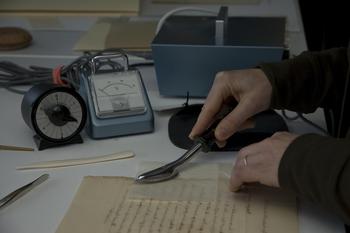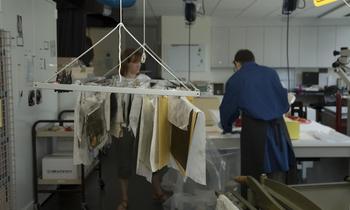A week ago on the blog, we learned about a massively destructive 1865 fire in the Smithsonian’s history. Beyond the well thought out fire-proof reconstruction Smithsonian Secretary Joseph Henry started soon after the fire, what have we learned since that fateful day? Well, incidents can and do still happen, despite all the controls that Henry thought appropriate, and the precautionary measures that the Smithsonian has in place for the safety of visitors, staff, and collections. Indeed, today marks another “fire-versary”—one that took place a year ago today, and occurred in a mechanical building happily located outside the National Museum of Natural History.
This past fire, like the one in 1865, also seems to have been caused by contractor error. Another reminder of the dangers that are ever present in infrastructure and construction, this incident gives weight to the fact that locating some mechanical facilities outside of collections-holding buildings wherever possible, especially in historic structures, is a great idea.
At another cultural resource nearby, the historic Georgetown Public Library, a lawsuit was recently settled in court over a 2007 construction-based fire. Do you see a pattern here? In one of my emergency management studies courses I heard the apocryphal statistic that some ninety percent of museum and library disasters occur during construction. Certainly in my fifteen-plus-years career, my disaster response activity has been evenly split between infrastructure failures and construction/contractor related incidents, as well as the rarer staff-caused incident. At least three notable episodes of carelessness that led to collections damage response and recovery occurred on the eve of a holiday weekend—due perhaps, to people rushing at tasks and forgetting certain protocols before their vacation—all of which made discovery and recovery more challenging. For a brief overview of protecting buildings and collections during renovations, see this video by the Northeast Museum Services Center:
Construction Projects - Emergency Preparedness for Museum Collections, Northeast Museum Services Center.
However, construction and contractors cannot bear all the blame—fires can also be caused by carelessness, improper protocols, or lack of policy within an organization. While the welding, cutting, and brazing operations of exhibit preparators and metal conservators work pose some risk, the small hot tools and appliances used by conservators and technicians, as well as kitchens and restaurant services, are also in need of monitoring and safe best practices. One way to start with this is to integrate OSHA’s guidelines for Job Hazard Analysis into lab and site management plans and practice, and provide mechanisms for oversight of compliance such as training, guidelines, and inspection. A very useful Fire Safety Self-inspection Form for Cultural Institutions is downloadable from the National Archives’ website—see the section in particular for Conservation Laboratories, Restoration Shops, and Bookbinding and Other shops for ideas on preventing hazards. They also have an article up on “Special Challenges - Fire and Fire Suppression; Warnings regarding the use of space not originally designed for the storage of archival and library materials”.

A list of notable fires of the twentieth century appears on the Museum Security Network, a useful forum for collections professionals. Outside of terrible circumstances such as the recent arson of the Institut d’Egypte and other acts of civil disturbance and intentional harm, many fire incidents can be prevented through disaster planning, response, and recovery actions. Of chief importance in any kind of construction—be it small retrofits or entirely new building wings—is coordination between collections managers, security and operations, and external first responders to be sure all appropriate protocols (such as hot work permits and inspections) are followed to minimize danger to staff, visitors, and collections.

Excellent resources on coordinated planning and response include Museum SOS, and the publication: Implementing the Incident Command System at the Institutional Level: A Handbook for Libraries, Archives, Museums, and Other Cultural Repositories. Our colleagues at the American Museum of Natural History in New York have put together a nice primer that covers the basics of Risk Management models, which includes some links useful for small organizations.
With coordination, careful planning, and monitoring, many of the fires that occur at museums, libraries, and archives can be avoided.
Produced by the Smithsonian Institution Archives. For copyright questions, please see the Terms of Use.


Leave a Comment